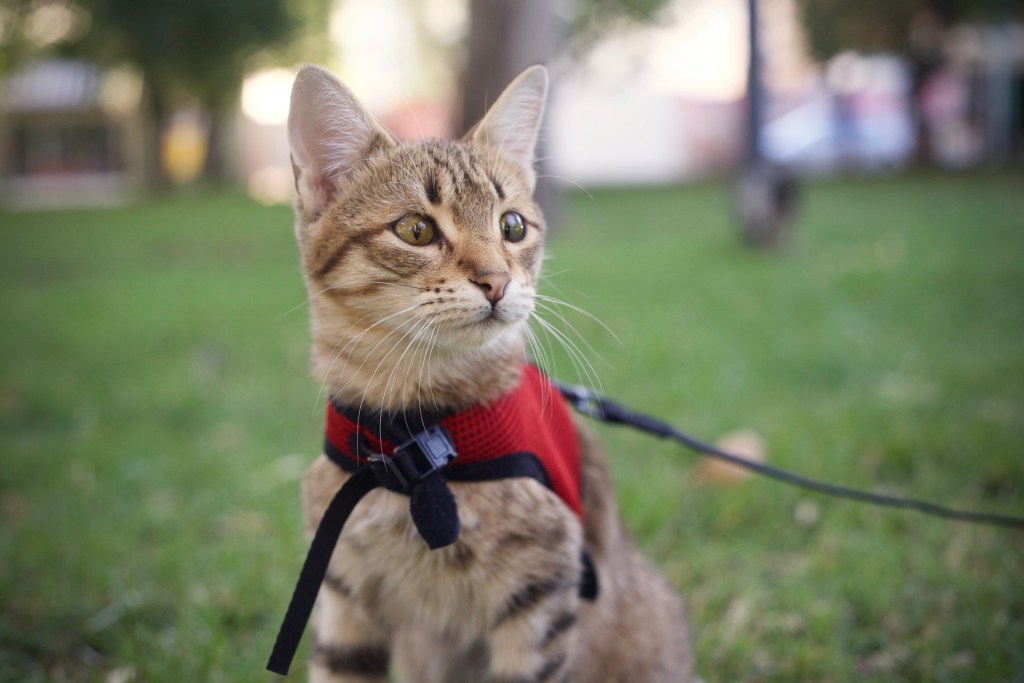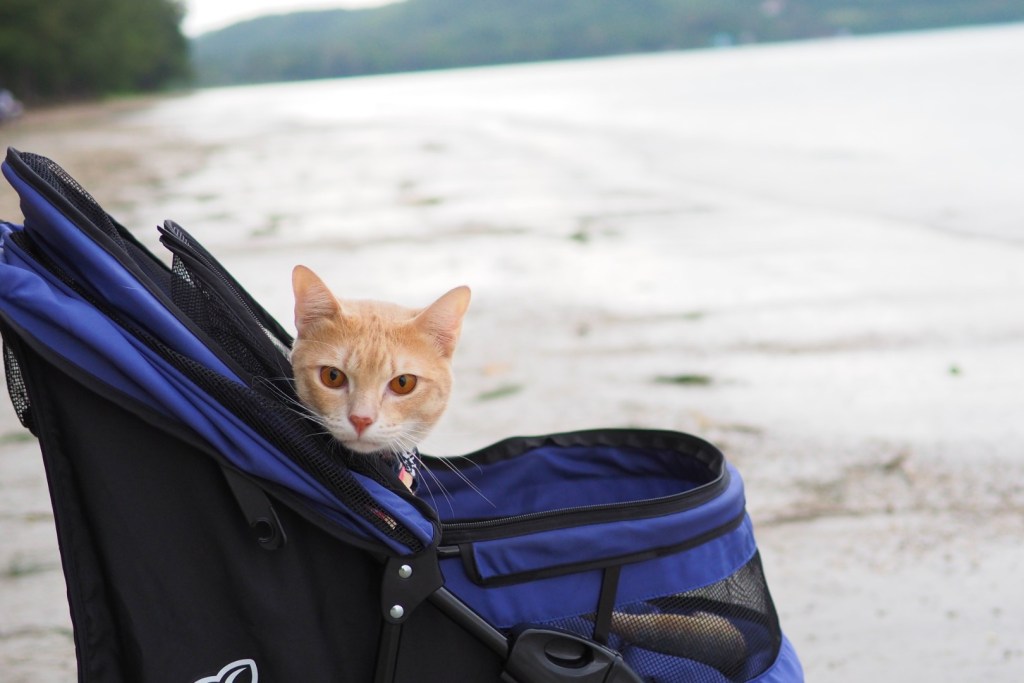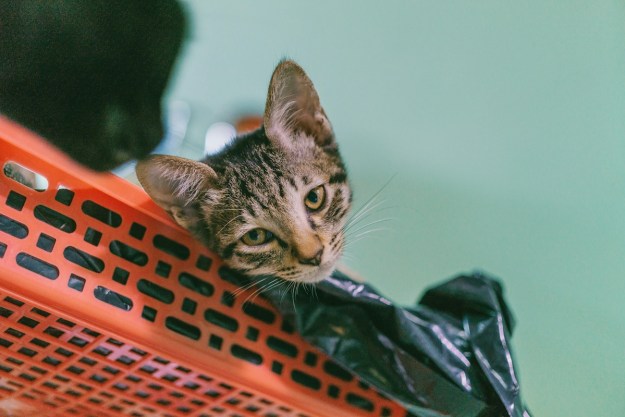Cat strollers and leashes are common tools pet owners can use to take cats outdoors safely, but which one is right for your cat? Both are effective methods, so the answer will depend on your cat’s needs and purpose for going outside. If you’ve trained your cat indoors, there’s simply no way for them to get the wild experience their big cat brothers and sisters encounter on a daily basis. But they still need enrichment to ensure mental health and well-being.
It may be too dangerous (for your cat and the small animals and birds) to allow your cat outdoors unrestrained, but cat strollers and leashes are a wonderful way to give your favorite feline(s) precious outdoor time so they’re not left out. In this article, we’ll go over the pros and cons of each in the cat stroller vs. leash debate, so you can decide which will work best for your cat’s temperament.
Cat leashes — the basics

A well-made cat leash is a simple way to give your fur baby time outdoors and freedom to romp safely there. But consider yourself warned: using a leash on your cat is very different from walking a dog. Cats aren’t as responsive to human commands as dogs because they have evolved a different response to human companionship. If you think you’ll use a leash because your dog uses one, prepare yourself.
Using a cat leash
It’s safest to use a cat harness with a leash because cats may slip out of their collar more easily than dogs will. A harness ensures your cat is secured but has freedom of movement within the boundaries of the leash.
Make sure your harness fits your cat snugly but not too tightly. You should be able to fit two fingers underneath the harness without a struggle. Leashes should be lightweight, but tough — woven nylon is often a good choice.
Preparing your cat
If you have a kitten, it may be possible to start with a leash without too much trouble. With adult cats, you might have to mix cat leash training with a lot of patience:
- Allow your cat to explore the harness and the leash without putting them on. Keep a favorite treat nearby and reward your cat for sniffing or interacting with the leash and harness.
- Put the harness on your cat if you’re able to. This may take a few days with treats before your cat trusts the situation.
- Let your cat wear the harness around the house to get used to it. It’s not necessary to wear it all day, but give it some time.
- Attach the leash and practice walking in your house to make sure your cat cannot escape.
- When you go outside for the first time, pay close attention to your cat and go slowly.
Leash pros:
- Your cat can explore the environment directly.
- Leashes give cats more freedom, something that may be more enjoyable.
- Leashes are less expensive than strollers.
Leash cons:
- Not much protection from other animals.
- Some cats may never accept the harness or leash.
Cat strollers — the basics

A cat stroller can give your cat some fresh air and mental stimulation while providing a safer, more protected environment when you’re out on that walk. If your cat won’t walk on a leash no matter what you try, it’s not doomed to indoor life forever just yet. Cat strollers are a more significant investment but could be worth it.
Using a cat stroller
Cat strollers are a lot like baby strollers, but they’re enclosed completely to ensure your cat can’t escape. Usually, it’s a mesh screen that zips or covers the basket, allowing your cat to see and breathe but keeping your cat completely covered. There’s not as much training involved as with a leash — zip your cat into the stroller and go.
Cat strollers come in a variety of sizes and shapes. The basic design is up to you, but your cat should be able to see out of multiple spots in the basket. Make sure the area is large enough for your cat to lie down or sit up without bending.
Look for strollers that have what you need, too. Some offer storage for your gear while you’re out, and you can even find double-decker options for multiple cats or a cat and a small dog. If you have more than one cat, make sure there’s enough room for both cats, whatever you choose.
Preparing your cat
While a stroller may not require as much training as a harness and leash, you still need to prepare your cat before you take that first long walk:
- The first thing to do is bring your stroller out to allow your cat to explore. Keep treats on hand.
- Place your cat inside the basket without zipping it up. If your cat has a favorite blanket or cushion, using it may help.
- Zip your cat up inside the basket and ride around in your home. If your cat is nervous, do this for short periods, gradually increasing as your cat gets more comfortable.
- Head outdoors but watch your cat closely for signs of discomfort or distress.
Stroller pros:
- Cats are more protected on walks.
- Strollers may help cats that will not accept the leash to head outdoors.
They offer more storage and make it easier to walk multiple cats or pets.
Stroller cons:
- Strollers are a more significant investment.
- Cats may eventually tear up the mesh.
Choosing the right outdoor aid for your cat
Your circumstances and your cat’s personality will determine which option is the right one for you. Remember to have some patience with your cat, especially with cat leash training. It could take some time for your cat to get used to either option.
The results are worth it. With some consistency, your cat can have some important time in the fresh air. Find your sweet spot and use these tools to keep your cat safe while exploring the great outdoors.
Editors' Recommendations
- Why do cats’ eyes dilate? What your pet’s extra big peepers mean
- Cats chirping at birds is totally normal (and here’s why you should encourage it)
- How to find the right veterinarian for your pet
- Why do cats roll in dirt? 10 reasons for their dust bath
- Why do cats cover their face when they sleep? This adorable behavior, explained


